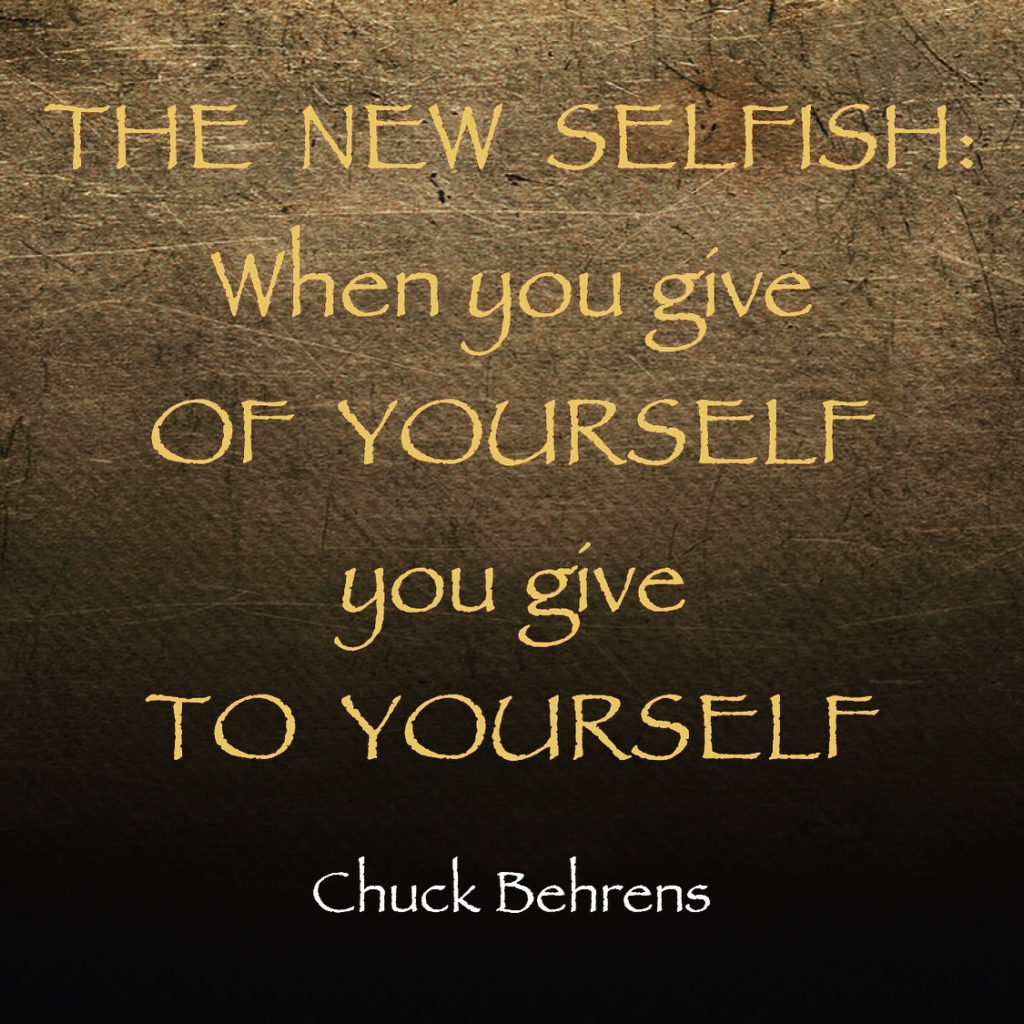In just a moment, we usually know right now and quick the difference between thinking really, really great things I mean, imagining the impossible versus doing just really simple things, good things: paying for a guy’s cup of coffee, paying for a couple that you look across the room and you see they’re sitting at the diner you’re in and you pay for their bill, or you see a little girl asking her daddy if she can have a doughnut and he said, Oh no, not today, honey, we don’t have the money,” but you go up to the cashier and you make sure that they do have the money or, or maybe it’s just a simple somebody popped into your head and you think about “wouldn’t it be nice not to buy him a big gift, but just to send them a card or a text to say, “HEY, you just popped in my head and I thought I’d send you a text just to see how you’re doing for no other reason than (the most power two words): JUST BECAUSE. . .It’s shameful and I’m not proud of it, but I do so many great things that I think about that I imagine in my head, that I never actually do, and if in fact, I did half the things that I thought about for the good of somebody else, I can’t imagine how much better the world would be or individual people.
“I thought it was a good idea at the time,” and then I didn’t act on it. So it’s not so much my New Year’s resolution as it is my Lifetime resolution: When somebody pops into my mind or when I wake up, thinking of them or when I see them I just wanna text them, or stop by, or send them a card let him know that I’m thinking of them; and if I just did that one thing, nothing more just that one thing, what a difference it might make not just in them, but just their simple day and their day-to-day routines to know that somebody thought about them and acted on itI don’t know if this will make a difference. I hope I am A Caring Catalyst enough to find out and more, inviting you along with me to find out, too.
Here’s your LICENSE to go a little past
THINKING
and
D O I N G
the next best thing. . .
ALONE. . .WITH YOUR THOUGHTS
Most of us feel like we just need to
STEP BACK
and take a moment to process
TO THINK
and some of us do all we can
to make sure we don’t. . .
WHAT SAY YOU
How to Enjoy Being Alone with Your Thoughts
It’s hard to think pleasant thoughts—but a new study suggests a quick way to make it easier. . .
Kira M. Newman of the Greater Good Magazine took an inside peak of dealing with our THOUGHTS, Alone.
Be optimistic. Think happy thoughts. Lots of happiness advice makes it sound as if we could flip a switch and fill our heads with puppies and rainbows—and wouldn’t that be great?
But it turns out that positive thinking isn’t so easy. In an infamous 2014 study where people had 15 minutes to mentally entertain themselves, about 40 percent chose to help pass the time by—no, not meditating—receiving an electric shock.

In fact, a recent study found that only 13 percent of people’s thoughts are positive and inner-directed, and they enjoy those thoughts more when they arise spontaneously. (In other words, they prefer that happy thoughts come naturally rather than putting in the effort to “think positive.”)
Could this process be easier and more enjoyable? It’s not an idle question: According to the researchers behind the new study, if people were better able to generate pleasant thoughts, they might rely less on technology for constant stimulation. It could help those who have trouble falling asleep, or who start pounding the steering wheel in traffic.
The researchers didn’t find a magic switch. But they did discover a simple trick.
Across four studies, more than 250 college undergraduates and 800 online participants started by listing eight topics they’d enjoy thinking about, including memories, fantasies, and things they were looking forward to. People wrote down everything from their wedding day to Valentine’s Day, their family or the summer, eating decadent cake, or living in the World of Warcraft universe.
Next, participants (alone in a room) were instructed to entertain themselves for four to six minutes with thoughts about the topics they had listed. “Your goal should be to have a pleasant experience, as opposed to spending the time focusing on everyday activities or negative things,” the researchers advised.
That was it, except for one small difference: Half of the participants had access to their list of topics, either written on notecards or displayed on a computer screen one by one. The other half didn’t.
Afterward, participants rated how pleasant the activity was (how enjoyable, entertaining, and boring) and how cognitively difficult it was (how hard it was to concentrate, how much their mind wandered, and how much time they devoted to irrelevant topics).
Ultimately, the researchers found that the group who could look at their list of topics found the experience more pleasant and less cognitively demanding. All the participants had made lists in the first part of the experiment, but having access to that “thinking aid” was key.
“Often when we have a few free minutes, we reach for our cell phones to entertain us,” says Erin C. Westgate of the University of Virginia. “But with a little planning ahead of time, we might be able to use our own minds instead.”
She and her co-authors (including Daniel Gilbert of Harvard University) speculate that the list might have made it easier for people to concentrate; to remember their go-to, happiness-boosting topics; or to decide which one to think about when.
After reading this study, I’ve already put up some kind of posters and art work in my little man cave, filled it with images of loved ones, surrounded by my favorite books, with a great sound system and yes, even a nice ECHO that allows me to listen to music that seems to fit my mood or my anxiety at any given time. Those are certainly better than an electric shock!

SOME WORDS NOT OUR OWN
THERE ARE SOME WORDS
NOT MY OWN
THAT SAY SO MUCH MORE
THAN I COULD EVER WRITE
OR SAY
B U T
need to read or hear
than any that could bounce around in my head
or spill out of my pen
L I K E:
my brain and
heart divorceda decade agoover who was
to blame about
how big of a mess
I have becomeeventually,
they couldn’t be
in the same room
with each othernow my head and heart
share custody of meI stay with my brain
during the weekand my heart
gets me on weekendsthey never speak to one another
– instead, they give me
– the same note to pass
– to each other every week
and their notes they
send to one another always
says the same thing:“This is all your fault”
on Sundays
my heart complains
about how my
head has let me down
in the pastand on Wednesday
my head lists all
of the times my
heart has screwed
things up for me
in the futurethey blame each
other for the
state of my lifethere’s been a lot
of yelling – and cryingso,
lately, I’ve been
spending a lot of
time with my gut
who serves as my
unofficial therapistmost nights, I sneak out of the
window in my ribcageand slide down my spine
and collapse on my
gut’s plush leather chair
that’s always open for me~ and I just sit sit sit sit
until the sun comes uplast evening,
my gut asked me
if I was having a hard
time being caught
between my heart
and my headI nodded
I said I didn’t know
if I could live with
either of them anymore“my heart is always sad about
something that happened yesterday
while my head is always worried
about something that may happen tomorrow,”
I lamentedmy gut squeezed my hand
“I just can’t live with
my mistakes of the past
or my anxiety about the future,”
I sighedmy gut smiled and said:
“in that case,
you should
go stay with your
lungs for a while,”I was confused
– the look on my face gave it away
“if you are exhausted about
your heart’s obsession with
the fixed past and your mind’s focus
on the uncertain futureyour lungs are the perfect place for you
there is no yesterday in your lungs
there is no tomorrow there eitherthere is only now
there is only inhale
there is only exhale
there is only this momentthere is only breath
and in that breath
you can rest while your
heart and head work
their relationship out.”this morning,
while my brain
was busy reading
tea leavesand while my
heart was staring
at old photographsI packed a little
bag and walked
to the door of
my lungsbefore I could even knock
she opened the door
with a smile and as
a gust of air embraced me
she said“what took you so long?”
~ John Roedel (johnroedel.com)
were spoken first by
Someone Else
and echoing intimately within us
For An Ever. . .
ALL DAY SUCKERS
that deliver more flavor
that can be promised
. . .only enjoyed
MORE THAN A MOMENT
I took a Moment
and then to really honor him
I TOOK ANOTHER MOMENT
and PAUSED
without hitting any magical button. . .

Thich Nhat Hanh, a Vietnamese Buddhist monk who was one of the world’s most influential Zen masters, spreading messages of mindfulness, compassion and nonviolence, died this past Saturday, January 22, 2022 at his home in the Tu Hieu Temple in Hue, Vietnam. He was 95.
The death was announced by Plum Village, his organization of monasteries. He suffered a severe brain hemorrhage in 2014 that left him unable to speak, though he could communicate through gestures.
A prolific author, poet, teacher and peace activist, Thich Nhat Hanh was exiled from Vietnam after opposing the war in the 1960s and became a leading voice in a movement he called “engaged Buddhism,” the application of Buddhist principles to political and social reform.
Traveling widely on speaking tours in the United States and Europe (he was fluent in English and French), Thich Nhat Hanh (pronounced tik nyaht hahn) was a major influence on Western practices of Buddhism, urging the embrace of mindfulness, which his website describes as “the energy of being aware and awake to the present moment.”
In 2018, he returned home to Hue, in central Vietnam, to live out his last days at the Tu Hieu Temple, where he had become a novice as a teenager.
Thich Nhat Hanh dismissed the idea of death. “Birth and death are only notions,” he wrote in his book “No Death, No Fear.” “They are not real.”
That understanding, he wrote, can liberate people from fear and allow them to “enjoy life and appreciate it in a new way.”
His connection with the United States began in the early 1960s, when he studied at Princeton Theological Seminary in New Jersey and later lectured at Cornell and Columbia. He influenced the American peace movement, urging the Rev. Dr. Martin Luther King Jr. to oppose the Vietnam War.
Dr. King nominated him for the Nobel Peace Prize in 1967, but the prize was not awarded to anyone that year.
“I do not personally know of anyone more worthy than this gentle monk from Vietnam,” Dr. King wrote to the Nobel Institute in Norway. “His ideas for peace, if applied, would build a monument to ecumenism, to world brotherhood, to humanity.”
Thich Nhat Hanh was born Nguyen Xuan Bao in Hue on Oct. 11, 1926. He joined a Zen monastery at 16 and studied Buddhism there as a novice. Upon his ordination in 1949, he assumed the Dharma name Thich Nhat Hanh. Thich is an honorary family name used by Vietnamese monks and nuns. To his followers he was known as Thay, or teacher.
Thich Nhat Hanh began writing and speaking out against the war and in 1964 published a poem called “Condemnation” in a Buddhist weekly. It reads in part:
Whoever is listening, be my witness:
I cannot accept this war.
I never could I never will.
I must say this a thousand times before I am killed.
I am like the bird who dies for the sake of its mate,
dripping blood from its broken beak and crying out:
“Beware! Turn around and face your real enemies
— ambition, violence hatred and greed.”
The poem earned him the label “antiwar poet,” and he was denounced as a pro-Communist propagandist.
Thich Nhat Hanh took up residence in France when the South Vietnamese government denied him permission to return from abroad after the signing of the Paris Peace Accords in 1973.
He was unable to return to Vietnam until 2005, when the Communist government allowed him to teach, practice and travel throughout the country. His antiwar activism continued, and in a talk in Hanoi in 2008 he said the Iraq war had resulted from fear and misunderstanding in which violence fed on itself.
“We know very well that airplanes, guns and bombs cannot remove wrong perceptions,” he said. “Only loving speech and compassionate listening can help people correct wrong perceptions. But our leaders are not trained in that discipline, and they rely only on the armed forces to remove terrorism.”
Yeah, I took a moment last Saturday when I heard of Thich Nhat Hanh’s death
AND THEN I TOOK ANOTHER ONE. . .
Now
I’m inviting you to take a little more than
A MOMENT
not to pause
not to remember
not to honor
not to celebrate
a Life
BUT THE LIFE IN YOU
WORTH LIVING
WORTH SHARING
W O R T H
taking more than whatever we think is
A MOMENT
MIND WANDERER

ARE YOU ONE. . .
I’ve had some of my greatest dreams
why I’ve been open-wide-eyed awake
. . .YOU?
I schedule time
R E G U L A R L Y
to do some serious
MIND WANDERING
and it’s brought about
not only
blog posts
presentations
sermons
CHUCK-IT’S like:

a n d

a n d

. . .and so many others you’ve yet to even glimpse yet
because what once was criticized often to me
from countless Teachers and Professors
who claimed that I wasn’t
FOcusEd
and I’ll never get anywhere
D A Y D R E A M I N G
had no idea
that it was all of the puzzle pieces
that were coming together
willy-NillIE
to make up
mE. . .
IT ALL MADE ME START
w o n d e r i n g
exactly WHAT:
What Daydreaming Does to Your Mind
NOW:
Science suggests that mind-wandering freely to more pleasant and playful thoughts may improve our mood and foster creativity. . .
JILL SUTTIE, Psy.D., is Greater Good’s former book review editor and now serves as a staff writer and contributing editor for the magazine. She received her doctorate of psychology from the University of San Francisco in 1998 and was a psychologist in private practice before coming to Greater Good.
Jill game me some new insight and made me a big believer in daydreaming now and then—especially when I’m out walking. There’s something about being in nature, making motion that helps me let go of daily cares and allows my mind to wander where it will, which feels great and often jumpstarts my creativity as a writer and a speaker.

I admit, though, I’ve been troubled by research showing how mind-wandering could make me less productive or depressed—the last thing I need! But it turns out this gap between personal experience and science may best be explained by how researchers have lumped together different kinds of mind-wandering. Not all research has differentiated between depressive rumination (like replaying an ongoing disagreement with our spouse in our minds) and pleasant daydreaming (letting our minds wander freely).
Now, some newer science is painting a more nuanced picture of what happens to us when we let our minds wander. Though the research is young and growing, it suggests that daydreaming may actually make us happier and more creative—if we do it the right way.
Daydreaming may be good for creativity
Anecdotally, mind-wandering has been associated with creativity for centuries. But this link to creativity may depend on the type of mind-wandering you do, as a new study by the University of Calgary’s Julia Kam and her colleagues suggests.
In this study, researchers used electroencephalogram technology to see what happens in our brains when we are engaged in different types of mind-wandering. To do that, they had people perform a mundane, repetitive task and interrupted them occasionally to see what they were thinking about, while continuously monitoring their brain activity.
Some participants reported thoughts that Kam calls “constrained,” involving things like ruminating over a fight with a spouse or thinking about how to manage a work problem. While these thoughts were not related to the task at hand, they were still somewhat focused. Others reported thoughts that were “freely moving”—meaning, they skipped from thing to thing—perhaps daydreaming about a future vacation in Italy, then wondering if they needed a new bathing suit, then fantasizing about an old flame.
When Kam and her colleagues matched people’s thoughts to their concurrent brain activity, they found signature patterns for different types of mind-wandering. In particular, freely moving thoughts were associated with increased alpha waves in the brain’s frontal cortex—a remarkable and novel finding, says Kam.
“What’s really striking about finding this neural marker is that it’s been implicated during studies of creativity,” she says. “When you introduce alpha oscillation in the frontal cortex, people perform better on creative tasks.”
This kind of brain activity maps well on to one particular aspect of creativity—divergent thinking or thinking “outside the box,” she says. When you’re generating ideas, you want to be able to go in many directions and not be constrained, which freely moving thought allows.
Mind-wandering has also been shown to enhance convergent thinking: what happens after you’ve brainstormed ideas and have to pick the best of the bunch, she adds. So, it’s likely that mind-wandering serves a creative purpose.
“If a problem has built up in your mind and you need to find a solution, letting it go into the background for a bit probably helps,” she says. “Mind-wandering facilitates the kind of solution that just comes to you, as in a lightbulb moment.”
This mirrors results from a 2015 study conducted by Claire Zedelius, formerly of the University of California, Santa Barbara. She looked at how mind-wandering affected people’s performance on a creativity test where they have to come up with a novel word (e.g., “food”) that fits with three seemingly unrelated words (e.g., “fish, fast, and spicy”). She found that people who mind-wandered performed better on this task, the answer coming to them in a flash rather than through methodically testing different solutions.
“People don’t even know how they got to the solution—it was just suddenly there,” she says. “Mind-wandering helps with ‘aha’ types of problem-solving.”
In a more recent study, Zedelius looked at the contents of people’s thoughts to see how that related to everyday creativity (outside of a lab setting). Participants, including some creative writers, were prompted via cell phones throughout the day to report on the nature of their thoughts and, at the end of the day, how creative they had been. Findings showed that people’s minds often wandered to fairly mundane things—like planning for a later shopping trip—and that these thoughts had no effect on creativity.
But when people’s minds wandered in more fantastical ways (playing out implausible fantasies or bizarre, funny scenarios, for example) or in ways that seemed particularly meaningful to them, they tended to have more creative ideas and feel more inspired at the end of the day, too. Interestingly, this was true for both writers and everyday people.
“Writers probably do this for their creative process all the time—thinking through stories, considering ‘what ifs’ or unrealistic or bizarre scenarios,” says Zedelius. “But lay people will also do this more to be more creative.”
This suggests that the link between mind-wandering and creativity is more complicated than previously thought. It seems to depend on how freely moving your thoughts are, the content of your thoughts, and your ability to be removed from everyday concerns. No doubt, this explains why my daydreaming on a hiking trail has led to song or story ideas that seem to bubble up from nowhere.
Mind-wandering can help boost our mood
Prior research suggests a wandering mind is an unhappy mind: We tend to be less happy when we’re not focused on what we’re doing. And that’s likely true, if you tend to rehash past mistakes or replay social flubs when your mind wanders, or if your mind-wandering keeps you from fulfilling your goals.
Again, the content of wandering thoughts makes a big difference. For example, as one 2013 study showed, when people found their wandering thoughts more interesting, their moods actually improved while mind-wandering. Similarly, other studies have found that thinking about people you love or thinking more about your potential future than about what happened in the past produces positive results.
How you use mind-wandering may also be important. In some cases, people intentionally mind-wander—something that has been mostly unexplored in the research, but likely has distinct effects. As one 2017 study found, people who use daydreaming for self-reflection typically have more pleasant thoughts than people who simply ruminate on unpleasant experiences.
There is even some evidence that mind-wandering may be more of an antidote to depression than a cause. People who are depressed may simply replay events from their past to better understand what happened to cause their dark mood and avoid future problems. Also, when researchers studied whether a negative mood preceded or followed a mind-wandering episode, they found poor moods led to more mind-wandering but not vice versa, suggesting that mind-wandering may be helping people feel better.
Now, findings from a 2021 study suggest that mind-wandering that is more freely moving can actually improve your mood.
In this study, participants were prompted randomly via cell phone over three days to report how they were feeling (positive versus negative) and how much their thoughts were freely moving and related to what they were doing (or not).
After analyzing the data, the researchers found that when people’s thoughts were off-task, they generally felt more negative—similar to what earlier findings showed. But if their thoughts were free-moving, it had the opposite effect, helping people feel happier.
“Our findings suggest there might be positive aspects of mind-wandering,” the researchers conclude.
Again, I find that science supports my own experience. If I simply put myself in a space that lets my mind move freely, I don’t get depressed. On the contrary, I’m happier because of it.
Can we be better mind-wanderers?
While the research on this is still young, it does indicate there may be a right and a wrong way to mind-wander.
Kam warns that mind-wandering when you need to be focused on a task (or risk hurting yourself or others—like if you’re driving or doing surgery) could be problematic. But, she says, if you let your mind wander when you’re doing mundane tasks that don’t require focus—like knitting or shelling peas–it may help you feel better or come up with creative ideas.
“The context and the content of your mind-wandering is actually really important. It plays a role in whether you get a good outcome or a not-so-good one,” she says.
Though many of us have a default mode that takes our mind to dark places when we aren’t busily engaged, that doesn’t mean we have to stay stuck there. If we can divert our thoughts from those darker places, we’ll likely get more out of mind-wandering.
Kam thinks practicing mindfulness could help with that, as long as it increases awareness of our thoughts and alerts us when we’ve strayed into problematic thinking, which could then help us redirect our mind-wandering.
“Just having more control over when mind-wandering happens and the kind of thoughts that you have would be very useful,” she says.
Zedelius also says awareness matters. As many study participants told her, they had never paid much attention to where their minds went before being in her study, but found the process eye-opening.
“They would say, ‘I’ve become aware of patterns in my thoughts that I never noticed before—what I get drawn to,’” she says. “It makes me wonder if the repeated probing we do in our experiments could not just be used as a measure, but as a type of intervention, to see if awareness changes over time.”
Of course, even though daydreaming may be good for us, it gets a pretty bad rap in American culture. Americans tend to pride themselves on their strong work ethic—often translated as working hard for long hours with complete focus.
But people are not built to be “on” all of the time. Taking a mind-wandering break might be good not just for our creativity and happiness, but also for our productivity, especially if we are in jobs requiring focused attention that is draining to maintain. And, as long as it’s employed during times when complete focus isn’t required, it may improve our well-being without hampering performance.
We shouldn’t need an excuse to mind-wander, given that it’s part of our human inheritance. Besides, we’ve hardly begun to recognize what it can do for us, says Zedelius.
“My hope is that people will explore the limits of mind-wandering a bit more and try to mind-wander in a way that is bigger, more fantastical, more personally meaningful, and further into the future,” she says. “If people just really allowed themselves to playfully use this tool, they might be able to focus on creative solutions to big problems.”

HOW ABOUT A LITTLE MIND WANDERING
Psssssssssssssssssssssssssssssssssssssssssssst:
Dressing up or down
is optional
but the benefits
are
UNlimITEd
and
COUNTless
Can’t Stop FEELING

Sometimes I feel like a severe
S H A D O W
of myself;
I see myself clearly
I’m just not so sure if I
K N O W
what I’m seeing. . .
Have you felt like that
over this past year. . . ?

Does that statement help;
make things clearer
or does it just throw more mud in your eyes
and make them
more cloudy. . .
on the verge of literally
SHORT-CIRCUITING

MARKHAM HEID, a writer freelance writer wrote a piece six years ago
well before a year of battling a Pandemic
that talks about that
HAYWIRE FEELING
He tells us, when it comes to quelling stress, there are dozens of research-backed remedies. But the most effective treatment is always going to be the one you can stick with, says Dr. Lorenzo Cohen, director of the integrative medicine program at the University of Texas MD Anderson Cancer Center.
“Managing stress is not like taking antibiotics, where you take all the medication and then you’re done and cured,” Cohen says. “It’s a lifelong process, so you have to find something you can engage in regularly and indefinitely.” Even if every stress expert agreed that daily meditation is the optimal form of treatment—and that kind of consensus isn’t farfetched—it wouldn’t do you much good unless you could muster the time and self-discipline to practice on a daily basis. For a lot of people, that’s never going to happen.
Fortunately, in terms of its therapeutic power, meditation may not require a quiet room—just a quiet mind. . .which means you have to ask the question,
DO I WANT SUCH A QUIET MIND?
When you’re stressed, your brain races from thought to thought, and these thoughts tend to be anxious and infused with dread, Cohen explains. Maybe you’re freaking out about a work deadline or a family member’s declining health. The most effective stress remedies disperse those rapid, worry-filled thoughts by focusing your mind on the present, not on some calamitous future, Cohen says.
Meditation is a popular stress remedy because it’s all about this kind of mind-anchoring. But if you’re able to achieve that calm, quiet state of mind while running or weeding your garden, then either will be beneficial. One 2015 study from Dutch researchers compared physical activity to mindfulness meditation, and found them to be equally effective at managing stress. Even washing dishes can alleviate anxiety—provided your attention is focused on the task at hand.
On the other hand, research shows your gym session or yoga practice won’t chill you out if your brain is preoccupied with work or family problems while you’re doing them. “They’re still healthy practices, they’re just not beneficial in terms of stress,” Cohen says.
So what’s your best course of action? First, check out mindfulness meditation. There’s compelling evidence to suggest it really is the antidote to our frenetic, future-focused way of life, Cohen says. Even if you don’t stick with it, the stuff you’ll learn can inform everything else you do—from preparing presentations at work to planting flowers in your garden.
At the same time, regular exercise bolsters your psychological health in myriad ways. “The ideal stress treatment would be to have both exercise and mindfulness on board in your life, not one or the other,” Cohen says.
A third weapon in your anti-stress arsenal is nature. Spending time on wooded trails or in other natural outdoor environments—any place away from man-built stuff like streets or buildings—appears to trigger an immediate drop in stress, says Tytti Pasanen of the University of Tampere in Finland. More research shows just looking at photos of nature is enough to mellow you out.
As you might expect, combining exercise with natural outdoor environments seems to be especially great at combating stress, Pasanen’s research shows. “I would advise regular physical activity in nature, on a weekly basis if possible,” she says.
Mindfulness practices. Exercise. Nature. Combine all three, and your stress won’t stand a chance.

SOMETIMES
I feel like a severe
s h a d o w
of myself
like my thoughts are not mine at all. . .
The Dalai Lama recently said,
“Scientists declare that it’s human nature to be compassionate. All living beings who experience feelings of pleasure and pain ultimately survive as a result of love and compassion. If we human beings help each other, serve each other, with compassion, we’ll be happy”
. . .I’m not sure if that’ll cause you to meditate
or even think much;
here’s hoping you can
F E E L
I T
Zzzzzzzzzing Better

How are you been sleeping?
It’s a pretty good question during the ever ongoing Pandemic
which has literally left us
at best
R E S T L E S S

Hey. . .
You want to sleep better?
(even if it doesn’t ever mean longer)
Here’s a few blinking hints:
Research suggests that practicing gratitude, forgiveness, mindfulness, and self-compassion may improve our sleep during these stressful times. . .
JILL SUTTIE a journalist for The Greater Good shares what it seems like we’ve been sharing with each other over these past 13 months.
A lot of us are suffering from lack of sleep these days. According the Centers for Disease Control, about 35% of adult Americans regularly get less than seven hours of sleep per night, with African Americans and other minority groups sleeping even less than that.

With the pandemic still in full swing, we may have even more sleep problems than usual. Worries about our health and safety, jobs, kids’ disrupted education, and more are keeping many of us up at night, creating fatigue and stress the next day. This could also lead to more serious mental health issues, like depression and even suicide.
Improving “sleep hygiene” is a good remedy—including going to bed at the same time every night, making sure your room is dark and quiet at bedtime, forgoing afternoon caffeine, and creating sleep-time rituals (like putting on cozy pajamas and reading a book before bed). But many people still suffer from sleep problems even after making these adjustments. And, though turning to sleeping pills can be effective, they can also be addictive, or they can disrupt our dreaming, which leads to lower-quality sleep.
Fortunately, there may be other things worth trying to help us sleep that have more to do with our minds than our bodies. Recent research suggests that many of the well-being practices we can do to be happier also have a positive effect on sleep. Here are some of those practices.
Mindfulness meditation
For the record, I’m not a big Mindfulness Meditation (or any other kind of meditation) guy. BUT, a recent analysis of several high-quality studies (randomized controlled trials) concluded that mindfulness meditation programs help people fall asleep more easily and experience better-quality sleep overall.
One study conducted in Wuhan, China, actually looked at how mindfulness might be useful for sleeping better during the COVID-19 pandemic. In the study, people spent 10 days using an app that either guided them through mindfulness meditation or induced mind-wandering (unfocused attention). They then reported how mindful they were and how much sleep they got the next day.
After taking into account other factors influencing sleep (like how much caffeine people drank, their age, or prior anxiety levels), the researchers analyzed how long people slept as the virus spread and deaths proliferated in their community. Those who practiced mindfulness and became more mindful didn’t lose as much sleep as those in the other group, likely because mindfulness protected them some from worry and rumination. Mindfulness helps people recognize and accept negative thoughts and feelings without fighting them, reducing their intensity and preventing them from spiraling out of control.
If you’ve not already tried mindfulness meditation, you can find many online resources to give it a go—including apps, which seem to be at least somewhat effective. You can also go to Greater Good in Action and try our practices—including a body scan, mindful breathing, or common humanity meditation. These exercises, besides potentially helping with sleep, have been found to reduce stress and depression and increase happiness and satisfaction with life, too.
Self-compassion
Self-compassion is something all of us could use right now, especially as lockdowns drag on and we find ourselves feeling more tired, unhappy, and unproductive than usual. Getting down on ourselves for perceived mistakes and flaws could exacerbate low-grade depression, which many of us already feel.
Self-compassion helps us to be kinder to ourselves as we go through the ups and downs of life. According to researcher Kristin Neff, self-compassion involves paying attention to our internal and external experiences (mindfulness), recognizing when we are suffering and sending kind messages to ourselves, and keeping in mind our common humanity—that we are not alone in our imperfections or suffering.
Studies have found that more self-compassionate people have better sleep, including less trouble falling asleep after a stressful day. In that study, people who were more self-compassionate were also in a better mood and felt more alert upon awakening than those with little self-compassion.
Self-compassion can be strengthened with practice, and that improves sleep, too. In one study, participants were asked to think about personal mistakes they’d made before going to bed and assigned to do a self-compassion meditation, a self-compassion writing exercise, or neither of those (as a comparison). Based on their reports the next morning, those who did a self-compassion exercise slept significantly better and ruminated less than those who didn’t try self-compassion. These practices even helped people who started out more depressed, which is good to know, given how many of us are ruminating more these days.
A new paper analyzing the results of several studies found there was “a significant association between self-compassion and self-reported sleep quality.” Though more rigorous studies could be done to confirm this, we can always benefit from practices like writing ourselves a self-compassion letter or taking a self-compassion break.
Gratitude
Feeling grateful is a good way to feel happier and strengthen our relationships. Now, it appears to help with sleep, too.
In one study, 119 young women were randomly selected to write about people and things they were grateful for each day, things that happened each day, or nothing at all. After two weeks, people’s sleep quality improved significantly in the gratitude group, and this helped improve their well-being and optimism and reduce blood pressure, too. In a recent review of gratitude exercises and their effects on physical health, researchers found that one of the strongest impacts of gratitude was on sleep quality.
One reason gratitude may affect sleep is that a grateful mindset seems to help us embrace more positive thoughts and let go of more negative ones before we go to bed. This means that it doesn’t take as long for us to fall asleep at night.
To try gratitude practices yourself, you might consider keeping a gratitude journal (or use the GGSC’s Thnx4 online journal) or writing a gratitude letter. These are designed to increase your positive thoughts and feelings, which may be key to better sleep.
Forgiveness
For some people, forgiving others is hard—especially if you equate forgiveness with letting someone “off the hook” and condoning their harmful actions. But those who study forgiveness consider it to be not necessarily about healing relationships between people, but mostly important for ourselves, helping us to let go of grudges that decrease our personal well-being.
If what’s keeping you up at night is holding on to grudges—pandemic-related or not—it could be worth considering practicing forgiveness. Though there is little or no direct research on how forgiving someone affects sleep directly, there is at least one study that found forgiving types were more likely to sleep better at night than others. Additionally, those who were more self-forgiving in the study also slept better because they were able to let go of mistakes they’d made more easily.
Forgiving someone can make us feel happier, more hopeful, less depressed and anxious, and less vulnerable to stress. And it can improve our relationships with others, especially our closest ones, which is important when so many of us have limited ability to interact with others right now. Each of these benefits is also tied to better sleep, which is all the more reason to try practicing forgiveness.
The nice thing about all of these practices is that they can be used alone or in tandem, and they don’t have undesirable side effects. Not only that, practicing these keys to happiness can have the desirable side effect of helping you become a happier, healthier person. That’s something we can all cheer about in these dark times. Just don’t try cheering right before you want to fall asleep!

Ahhhhhhhhhhhhhhhhhhhhhhhhhhhhhhhhhhhhhhh
(BIG YAWN)
Sleep Tight(er)
I have a MIND to. . .
M I N D F U L N E S S
. . .talk about a buzz word
that may not be always completely
m i n d e d

What Mindfulness Actually Means
A couple of journalists, Peechaya Burroughs for TIMEBY CATHERINE CUELLO-FUENTE pull back the
MINDFUL Curtain
and give us some glimpse of what this
M I N D F U L N E S S
might be all about:
There’s a lot of talk about mindfulness lately, but what does it actually mean? “Mindfulness” is a translation of the Buddhist concept of sati. Sati, which Buddhists consider the first of seven factors of enlightenment, means, “memory of the present,” and that’s exactly it:
Mindfulness means to be present.
Mindfulness means to slow down, to be kind, to look at someone and not through someone. To accept that life has its ups and downs but that, in the end, the downs pass like clouds in the sky. It’s realizing that, even though it may be easier to run than to walk, it is in stillness or slowness that you start to find beauty around you and in everything that you do.
Mindfulness helps you enjoy the day-to-day and teaches you that there is no better place to be than where you are right now. You learn to see things that are unpleasant as temporary or as tiny chapters in the larger story that is your life. Our culture makes us believe that only big life events—birthdays, a promotion, graduation, New Year’s Eve—are worth celebrating. As a result, we end up underappreciating the things that we do every day.
I see people all the time who do not realize their worth. They complain because they’re so focused on what they are looking forward to that they cannot be mindful and enjoy what is in front of them. And with the dying, it sometimes can be magnified to make it so much worse or it focuses them like they’ve never been before in their lives and they see with a clarity no corrective lenses could ever promise. Unfortunately, as it usually happens, I had to hit rock bottom to learn this myself. . .We all do and maybe the secret is:
HIT THE BOTTOM FAST
or
RAISE THE FLOOR
so the Fall
is more like a step
than an abyss. . .
Have you ever had those definable moments when you utterly feel:
I wasn’t fulfilled,
I wasn’t challenged or
I wasn’t enlightened. . . ?
THE ANSWER?
Well. . .
LOOK WITHIN
(except there’s no compass, there’s no GPS, no real manual for that journey)

M I N D F U L N E S S
is well. . .
m i n d f u l
and there are many ways to
attain it
but none
more important than
Y O U R
W A Y

M I N D F U L N E S S
It’s not about the
L a y e r s
so much as knowing which
o n e
you occupy
N O W

M I N D
k i n d. . .
why stand in front of a mirror
catching your reflection
when you can see yourself
from the inside
in a way that can’t be reflected
ONLY REFLECTIVE
?

I have a mind to. . .
be more mindful,
Y O U ?

SNOWING when it DOESN’T
While others were complaining
about it
S N O W I N G
again
and yes,
I absolutely was tempted. . .
I caught myself
and literally stopped in my tracks for
just a couple of minutes
T O R E C O G N I Z E W H A T I N O T I C E D. . .
Amazingly
when I just did that for two minutes
and a mere seven seconds
The other side of the coin flipped for me
and instantly
instead of literally joining the Masses
and severely
C O M P L A I N I N G
about it being APRIL 8
and it was snowing
A G A I N. . .
i instead heard the most amazing
symphony being composed and performed at the same time
by an orchestra and chorus of birds
who were in the snow like me
and singing back in defiance
WHO CARES, WHO CARES, WHO CARES, WHO CARES, WHO CARES,
and I stopped myself and S A N G
back this amazing refrain from an inner voice
I didn’t recognize:
I DO, I DO, I DO, I DO, I DO, I DO, I DO, I DO, I DO, I DO, I DO, I DO, I DO,
and I did
. . .I finally recognized what I noticed
that m o m e n t s
even those sprinkled with snow flakes
on a April 8th Sunday Morning
on the edge of an empty Church Parking lot
where bare brush and trees only purpose
were to collect rare Spring snowflakes
are L I F E T I M E S
that never perish
and nor do the ones
who take the time
to recognize
what they notice. . .
I won the coin flip
to one of the biggest events
in my life
(this time)
but it was all I had
and all I wanted
in just two-minutes and seven seconds. . . .




